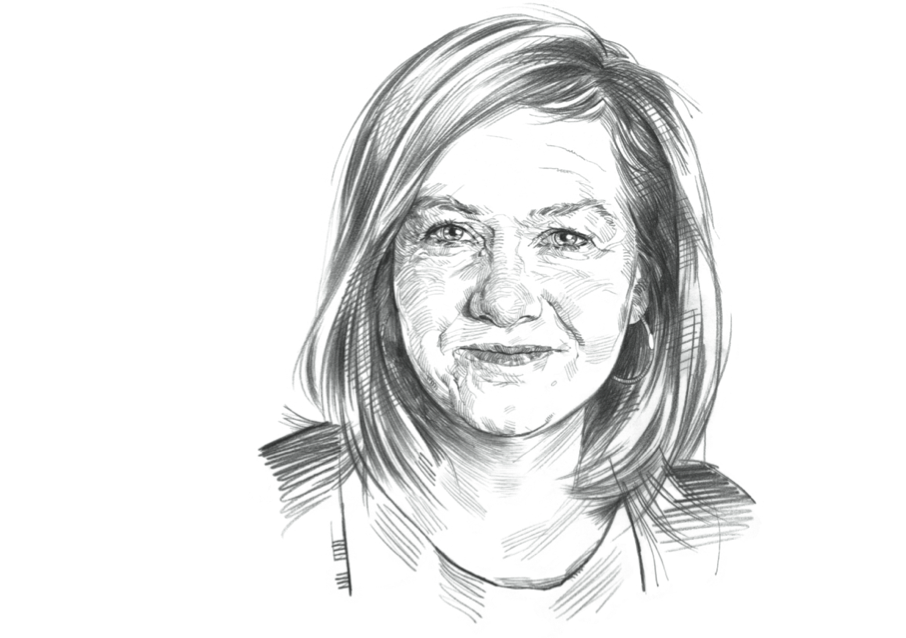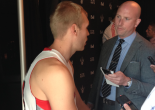Mission Impossible
Or so Post doomsayers claim. Why Anne Marie Owens says they’re wrong

Anne Marie Owens marks her arrival as editor-in-chief of the National Post with a laugh. It’s not a giggle, nor is it quiet. It is guttural and warm, a comforting capital-H Ha-Ha-Ha. It shakes her frame, all five feet, two inches of her. It comes out often. Post colleagues hear the laugh around the corner from their desks and from within glass-enclosed offices. Anyone who knows Owens knows her laugh. It seems to say: Yes, I am here now. I am laughing. Together, we can thrive.
The Post hasn’t had much to laugh about in recent years. Parent company Postmedia Network Inc., which owns 15 newspapers across the country, has endured tens of millions of dollars in quarterly losses, though it has pushed to cut costs over the past three years. That has led to layoffs and decreased circulation—but the turmoil was anticipated. The Post has teetered on the edge of death for years. In 2009, it almost succumbed when Postmedia went bankrupt, only to be revived by U.S. investment firm Silver Point Capital L.P. (the same company that saved Twinkie manufacturer Hostess). The newsroom of 110 journalists services nearly one million weekly print and digital readers. But the Post has turned a profit in only the last three of its 16 years.
In response to the company’s financial unrest, executives have committed to what president and CEO Paul Godfrey calls a “radical transformation.” It began in 2011 when Postmedia rolled out online paywalls for Montreal’s The Gazette and Victoria’s Times Colonist. Within two years, readers required a digital subscription to see more than 10 online articles a month for all Postmedia papers. “Newspapers around the world are realizing you can’t spend millions of dollars on content and give it away for free,” Godfrey said in 2013. By 2014, executives had created their latest attempt at salvation, a four-platform approach now known as “Postmedia Re-Imagined.” The plan will be released in its entirety by spring 2015, and incorporates new tablet and smartphone versions of the Post with the pre-existing web and print editions of the paper. Executives hope it will boost the Post’s weekly digital readership far past the current 240,000 per week mark and, in turn, increase ad sales.
In Owens, executives want an editorial ringleader who can find the balance between producing a profitable publication and maintaining the “Post spirit,” a loose term higher-ups use to reference the “good old days” of “fearless” print media. They have placed their faith in her energy and optimism to lead the Post through the final stages of its transformation into a digital-ready news organization. If it’s successful, Owens will have good reason to keep on laughing.
***
During her walk-through of the 11th floor of Postmedia’s office in Toronto, Owens comes off like a celebrity: in each room she enters, she receives a Cheers-like welcome. Everybody knows her—and her nickname, “AMO” (pronounced “ammo”). Colleagues stop their conversations to say hello; she always waves back. Even elevator rides are punctuated by chats with staff. “When I walk through like this,” she says, “it makes it seem like I’m everyone’s friend here.”
When I first meet her, Owens buzzes like a hamster on Red Bull. She is a fast talker and her sentences often begin with a convoluted “I think–but I–you know–.” When they aren’t in the air, her hands are drawing imaginary diagrams on the table in front of her. During our interview at the Post’s Collaboration Café—a cafeteria resembling an oversized Starbucks—she picks her hands up and slaps them back down so often that the table wobbles on its steel legs. She bobs her head, too, in time with her hands; the gold hoop earrings she wears dangle and tap her cheeks, moving like a metronome.
Owens’s predecessor Stephen Meurice was, as he says, “let go” from the Post last March, despite working for the paper since day one in 1998. After his departure, Post executives, including Gerry Nott, who assumed the role of interim editor, were desperate for a fast-moving leader. They sought someone who could take the reins and immediately begin forming the skeleton of a more organized and optimistic newsroom—someone who felt the same sense of urgency in kick-starting “Postmedia Re-Imagined.” Once hired, Owens moved quickly, taking four months to restructure her leadership team. After five managing editors left their positions, she appointed a single deputy editor: Julie Traves, who had been Focus section editor at The Globe and Mail. The managing editors were given more responsibilities for both digital and print, and became symbolically known as “executive producers.” The shift also included hiring Erin Valois from theScore. She brought experience in tracking how readers consume news to her new role as executive producer of digital. The former managing editor of features Benjamin Errett became director of strategy, a role that oversees the execution of the four-platform plan. The restructuring communicated a clear message: to survive, the Post can’t think of itself as a print product.
Much of the restructuring, it appears, is thanks to financial losses. Little more than a week before Owens’s first day on the job, Postmedia announced a quarterly loss of more than $20 million despite its three-year restructuring program that meant job cuts. In 2010, Postmedia slashed 500 full-time positions, followed by 25 additional cuts in 2012. Later on, job losses included some of the Post’s biggest names and most talented journalists: just two months before Meurice was let go, the paper laid off seven editors, including social media editor Jeremy Barker and sports editor Jim Bray. In March 2014, Postmedia terminated 48 jobs in the Calgary advertising sales office. Newspaper circulation also took a hit: the Calgary Herald, Edmonton Journal and Ottawa Citizen all lost their Sunday editions, while the Post hasn’t published on Mondays in the summer since 2009. Still, the losses kept coming. In January, eight months after Owens started, Postmedia reported a quarterly loss of $10 million.
To deal with the financial pressures, Owens has focused her attention on management. Five months into the job, she has yet to unpack all of her belongings in her office. “Nothing in there really says much about me,” she says. Instead, she has been training her leadership team to take on their new roles. When she isn’t in meetings, she’s usually whirling around the newsroom before deadline—not unlike the cartoon Tasmanian Devil.
Owens starts every day with a two-hour commute from Waterdown, Ontario, southwest of Toronto. She attends daily story meetings at 10:30 a.m. and 3 p.m. and usually leaves by 7 p.m. to head home to her husband, a teacher, and their four teenage sons. She spends her evenings refreshing her email to see proofs. All of her weekdays are the same: rinse, repeat.
When describing Owens, most of her colleagues paint a starry-eyed portrait of an energetic, happy-go-lucky editor. One goes as far as to call her efforts “superhuman.” Energy and dedication, however, aren’t enough to pull the Post out of its financial slump. During our interview, Owens puts a positive spin on her work, bouncing from idea to idea. When I probe about the survival of the Post, she acknowledges that Postmedia is financially unstable compared to her previous employer, Rogers Publishing, but then quickly changes the subject to reflect on how wonderful an opportunity it is to be editor-in-chief. After an hour, Owens ends our conservation to attend a meeting. I bank my follow-up questions on the stability of the paper.
Many of these questions, however, go unanswered—at least by Owens. While I spent the next four months analyzing the Post’s future under her leadership and asking dozens of her former and current colleagues what she’d bring to the paper, Owens never granted me another interview. Though she initially agreed to let me shadow her on the job, she later dodged my weekly requests to do so. In October, following another request to spend a day with her at the paper, I received my last response from her: “This is a bad week for me.” Perhaps she was just too busy—at the bottom of an Everest-sized to-do list as the paper undergoes its digital transformation. Or perhaps she just wasn’t interested in talking about the Post’s financial future under her reign.
***
Gender Equality, My Ass
Source: Newspapers Canada
Canada has 111 daily newspapers. While Anne Marie Owens is the first female editor of a national paper in the country, women are at the helm of 18 publications. Here they are:
B.C.
1. Siobhan Burns, Alberni Valley Times
2. Carolyn Grant, Kimberley Daily Bulletin
3. Melissa Fryer, Nanaimo News Bulletin
Alberta
4. Erika Beauchesne, Fort McMurray Today
5. Margo Goodhand, Edmonton Journal
6. Kerri Sandford, Medicine Hat News
Saskatchewan
7. Heather Persson, Saskatoon’s StarPhoenix
8. Lyndsay McCready, The Moose Jaw Times Herald
Manitoba
9. Johnna Ruocco, Portage Daily Graphic
Ontario
10. Anne Marie Owens, National Post
11. Wendy Metcalfe, Toronto Sun
12. Wendy Metcalfe, 24 Hours Toronto
13. Wendy Metcalfe, Ottawa Sun
14. Lynn Haddrall, Waterloo Region Record
15. Kim Novak, Simcoe Reformer
Quebec
16. Lucinda Chodan, The Gazette
17. Josée Boileau, Le Devoir
Nova Scotia
18. Sherry Martell, Truro Daily News
The Ottawa Citizen first tested “Postmedia Re-Imagined” in May 2014. Five months into the trial, company vice-president Lou Clancy dubbed it a success: readers were now spending 18 percent more time with the paper, largely, he claimed, because of its mobile accessibility and new smartphone and tablet editions (Postmedia has yet to break down the increase by platform). According to an introductory post on the Citizen’s website, the move was backed, in part, by a Postmedia-funded 2013 Ipsos Canada survey that found the company could reach several demographics through different platforms. Younger readers were more likely to read the news on their smartphones, while middle-aged readers preferred tablets and older readers favoured the printed page.
For the company’s executives, the Citizen’s results were encouraging. But how the strategy will hold up on a national scale is unclear. In the U.S., The New York Times similarly fragmented its audience in April 2014 by releasing several digital niche editions of the paper targeted toward different demographics. In October 2014, the organization experienced a third-quarter loss of $9 million, compared to an $12.9-million operating profit during that same period in 2013. It also announced the elimination of 100 newsroom jobs by the end of 2014. The Times might be able to afford the experimentation; Postmedia cannot.
Perhaps that’s why these efforts have moved so slowly with the Post. The paper’s most notable moves toward digitization were in 2011. At that time, 30 percent of Canadians were relying primarily on the internet for news consumption, according to a Canadian Media Research Consortium study. “Providers that fail to focus on providing content for computers, tablets and smartphones will be left behind,” declared the study’s co-author, Darryl Korell. In response to readers’ shifting tastes, newsrooms began to consider online paywalls. Consequently, one of Meurice’s big tasks was to overhaul the Post’s website. The digital focus reeled in profits for the first time. But then Meurice was let go. Though executives never told him exactly why, Meurice speculates they wanted “a fresh set of eyes on the paper.” He adds, “I was too invested in the old ways of the Post.”
Meanwhile, Owens, the effervescent former Postie, was at Maclean’s, helping launch a tablet edition and redesign its website. She quickly discovered she had a knack for digital thinking. In March 2014, the national newsmagazine’s online pageviews increased about 35 percent, and the popularity of its app helped Rogers Publishing reach one million downloads for all of its publications’ apps.
Owens says she never had a plotted job trajectory. Her career in journalism began in January 1988, when just eight months into her graduate degree at Western University in London, Ontario, (where classmates described her as a “great drunk dancer”), she landed a job at the St. Catharines Standard. There, she commuted three days a week between St. Catharines and London until she graduated and became a full-time reporter. Owens held multiple titles at the Standard—from education reporter to columnist—but her coverage of the case of serial rapist and murderer Paul Bernardo in 1995 gave her byline recognition. Realizing there was little room for more career growth at the Standard after the trial, she joined the Post’s inaugural masthead in 1998, anticipating big-city opportunities.
She worked her way up to general assignment reporter, often writing features, where she stayed until 2006, when Meurice nudged her into editing. “She had the kind of vision we needed with features,” he says, “and with dealing with other reporters.” Eventually, Owens stopped writing altogether and became features editor. From there, she moved up the ranks. By the time she jumped ship to Maclean’s in 2011, she was the Post’s managing editor of news.
Following Meurice’s departure, Postmedia senior vice-presidents Nott and Clancy handpicked Owens to fill the vacant spot. Her hire suggests executives saw a more versatile leader in Owens, someone willing to take digital risks, though Nott says it wasn’t a “him-versus-her situation.” Yet when I ask about her motivations for accepting the role, Owens’s answer surprises me. Rather than talking about multimedia innovation, she immediately lands on another, far different subject. “The job itself is great,” she tells me. “But the opportunity to be the first female editor of a national paper is pretty huge, right?”
***
Owens has always been a proponent of feminism and equality in journalism—something John Ibbitson, now writer-at-large at the Globe, learned on his first day of journalism school in 1987. The class of 40 had a simple task: interview your deskmate and write a brief story about his or her life. Paired with the gregarious Owens, Ibbitson anticipated an easy assignment. “Anne Marie Owens is an energetic, perky 23-year-old,” he typed, satisfied with his description. Upon reading the story, Owens was enraged. “Perky? Perky?” she exclaimed. Her voice went louder: “What man would ever describe a woman in all of human history as perky?” Ibbitson recalls the day with shame, even some 20 years later, and now admits, “I never used the word ‘perky’ to describe anything again in the rest of my career.”
Being a female journalist has informed much of Owens’s work as a reporter and editor. While at the Standard in the early 1990s, she and Marlene Bergsma successfully fought for the use of gender-neutral language in the paper. Around the same time, she purchased a Non-Sexist Word Finder at a small bookstore in Port Dalhousie, Ontario. It was her parody of a writing bible until 2011, when she jokingly passed it on to Meurice before she headed to Maclean’s. (Inside the book’s front cover, her signature remains in black ink.)
Not everyone agrees Owens’s gender is a big deal. When asked for his thoughts on her appointment as the first woman to run a national paper in Canada, Toronto Star editor Michael Cooke said, “It doesn’t matter.” Cooke, along with many of Owens’s male colleagues, says Owens being a woman has little effect on her ability to move up the ranks. Even the Post’s homepage editor and assistant managing editor, John Racovali, says that she landed the position on her own merit, so calling attention to the fact that she is the first female editor at the paper is “a hollow accolade.”
Yet, to say so is to ignore the male domination of the news industry. Ann Rauhala, a professor at Ryerson University’s School of Journalism, examines women’s roles in newsrooms. She points to a slew of reasons women aren’t often appointed to top-tier positions. For one, women who are juggling domestic responsibilities with their careers feel that their employers are not supportive. For another, executives want to hire journalists who are just like them, who reflect their values. “That translates to white guys hiring nice, young white guys,” she says. That Owens is heading a national paper is just not the norm—according to Newspapers Canada’s annual report for 2014, of 111 daily newspapers, only 18 have women in the top job.
But Owens’s feminist values won’t mean the end of the Post’s staunch, right-wing political commentary—or even define her reign as editor. Though the Post has come a long way from its origins as a “tits-and-analysis paper,” as the Star’s former executive managing editor James Travers once described it, right-wing columnists are part of the Post’s brand and are there to stay. “The Post,” stresses Owens, “is not sexist.” Well, not quite. Even with a self-proclaimed feminist at the helm, the Post still runs headlines such as “Feminist Video Turns to Child Abuse to Send Distorted Message.” And in December 2014, a Rex Murphy column denounced the efforts of mainstream feminists. “In an era when college students under the mighty sway of heteronormative patriarchy have conjured up the concept of ‘micro-aggression’ and stamped their books with ‘trigger warnings,’” he wrote, “there is surely nothing too silly, too intellectually vacuous, for educated feminists to embrace.”
At a time when anti-feminist columns like Murphy’s fare well with Post readers, it’s far easier to imagine Owens’s commitment to the digital overhaul shaping her legacy as editor, and her gender fading to an afterthought.
***
Rob Roberts knew he had a winning story on his hands when he assigned a piece about an avalanche to Post writer Joe O’Connor. It had all the right elements: a charismatic, hubristic main character, death, conflict and a Canadian backdrop. For Roberts, the executive news producer, a typical page three spread—several column inches dedicated to a longform feature—was in order. He slated it to go to print ASAP. But Owens said no. Go further, she instructed. The result was an interactive online feature, complete with high-resolution portraits of snow-covered mountains, on-camera interviews with O’Connor’s main character and infographics depicting the anatomy of an avalanche. The team published “The Day the Mountain Fell” in September 2014 and it soon garnered hundreds of thousands of pageviews. The Post has also published several popular multimedia stories that fall outside the realm of daily news, including Adrian Humphreys’s “Hacker, Creeper, Soldier, Spy,” a 15,000-word online interactive profile of a former U.S. military man seeking asylum in Canada (which began the model), and “Gangland Confidential,” his multimedia coverage of Canadian mafia ties in Italy.
Turning ordinary print features into interactive stories is a tactic Owens hopes to employ more frequently as the Post undergoes its digital makeover. As Roberts puts it, the focus is shifting from filling tomorrow’s paper to telling good stories in different ways—and, with the addition of smartphone and tablet editions, on different platforms. Owens isn’t the first to go forth with such a plan, and for most Canadian newspapers a move toward multimedia seems inevitable. By 2017, Canada’s newspaper industry could see revenues decline by up to 20 percent, according to a 2013 report by international financial firm PricewaterhouseCoopers. Anticipating that number will prove true—and could be even worse—many traditional news organizations have turned to web and tech-forward platforms, reframing a scramble to stay financially afloat into a bold and innovative path.
“Users are going to mobile—they’re often consuming their news on various apps via their mobile devices as opposed to any other platform,” says David Silverberg, editor-in-chief of Digital Journal, who has been following trends in the industry since 2009 through his Future of Media events in Toronto. In 2014, close to 60 percent of 18- to 34-year-old and 40 percent of 35- to 49-year-old Canadians consumed news on mobile devices or computers, according to a Media Technology Monitor report. The company also found 45 percent of anglophones now own a tablet. But, Silverberg adds, publishers need a good plan in order to successfully market their multiple digital platforms: “They can’t just take content and slap it onto a tablet or smartphone app.” Reformatting this content and giving it added value can help papers improve their chances. Often, that’s through interactivity, additional visual content such as infographics or presenting it in a prettier package.
Publishers must also confront what David Skok, a 2012 Nieman Fellow and current digital adviser at The Boston Globe, calls “disruption theory,” a term coined by his Harvard Business School professor Clayton Christensen. The theory refers to a dynamic whereby newer, more agile firms disrupt more established companies stuck in their old ways. During his fellowship, Skok and Christensen applied this theory to the journalism industry. While sites such as The Huffington Post (its parent company, AOL, is worth $3 billion) and BuzzFeed (worth $850 million) are successful, much of their revenue is generated through clicks on low-cost listicles and branded content. Still, news organizations can reinvest their clickbait revenue into features and harder-hitting news stories.
Yet under Owens, there is little room for for BuzzFeed-esque quizzes or viral videos. In fact, it contradicts her plan for “great storytelling and voices,” and it could be the core flaw in the digital strategy. Producing smart journalism across a series of platforms is great in theory, but it costs money and it’s unclear where the funding—especially at a publication that took 13 years to make a profit—would come from. Papers that have succeeded at rolling out multiple editions of their product over a series of digital platforms have invested millions in doing so. Montreal’s La Presse tablet app, for instance, cost $40 million and three years worth of research—money the notoriously poor Postmedia would be hard-pressed to match. La Presse has also announced it will eventually replace its print newspapers with an all-digital publication—something that seems unlikely at the Post, which has many older readers who still rely on paper and ink.
Owens did not tell me how she plans to balance the need for good content with the paper’s current financial state. Talking about her move to Postmedia from the financially stable Rogers, she said she appreciated the “experimental” nature of the Post. “All the tumult and all the uncertainty,” she says, “it does mean that you have a good environment for trying new things.” But company executives have never mentioned a back-up plan if the great “Re-Imagined” experiment fails. And if there is one, I never had the chance to ask Owens about it. During our brief interview, Owens said she would focus solely on the Post’s needs within the immediate future, planning for “whatever comes in the next six months and whatever comes in the year after that”—suggesting, perhaps, even she doesn’t know what will lead the Post into financial stability.
***
It’s a cold November night, and Owens is standing out in the “smoking patio” of Toronto’s Opera House, a shoddily taped-off barrier between the sidewalk on Queen Street East and the venue. Inside, hundreds of media professionals and news junkies are in attendance for Newzapalooza, an annual “battle of the bands” charity event during which journalists take on the role of rock stars for the night. Though she isn’t smoking, Owens is standing among a group of young women who crowd around her. Out here, she is the star.
This opportunity to mingle with Owens outside the newsroom after weeks of chasing her is rare and golden. And she is beaming with excitement: the crowd loved the Post’s band, Conrad Black Sabbath. But she ignores me for a while, turning her back toward me, until I say hello.
“Oh, gosh, are you still looking for colour for your story?” she asks me. She laughs. I ask again if I can shadow her, but the question hangs in the air as she re-enters the Opera House, disappearing into the thick of the crowd. It’s the last time I ever see her.
It reminds me of our interview. When I pressed her about where the paper is headed under her direction, Owens dodged the question in a different way: she pretended to be forthright. “If you ask, ‘What is the National Post going to look like five years down the road?’ I don’t think anyone can honestly say,” she said. Then she whisked on to the next subject. At the end of our only chat, she laughed that signature, booming laugh, as if to assure me: I have it all under control. This paper will thrive.
Illustration by Tony Healey
This story was updated to reflect changes to female editors at the helm of Canadian newspapers, including the departure of Janice Dockham at the Leader-Post and the appointment of Heather Persson at the StarPhoenix. The story also previously incorrectly stated that Adrian Humphreys’s “Hacker, Creeper, Soldier, Spy” was published after “The Day the Mountain Fell.” The Review regrets the errors.















































